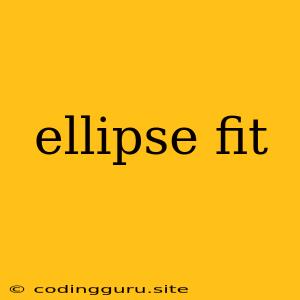Ellipse Fit: Unveiling the Secrets of Elliptical Shapes
The world around us is filled with a myriad of shapes, each with its unique characteristics and applications. Among them, the ellipse stands out as a captivating geometric figure, found in celestial orbits, architectural designs, and even biological structures. But how do we capture the essence of an ellipse when presented with a set of scattered data points? This is where the concept of ellipse fit comes into play.
Ellipse fit is a powerful technique that enables us to find the best-fitting ellipse that represents a given set of data points. It involves finding the ellipse parameters - the center coordinates, major and minor axes lengths, and rotation angle - that minimize the distance between the ellipse and the data points.
Why Is Ellipse Fit So Important?
The applications of ellipse fit are vast and diverse. Here are some key areas where it shines:
- Image Processing: In image analysis, ellipse fit is employed to identify and track elliptical objects, such as cells, nuclei, or astronomical bodies. By fitting an ellipse to the detected boundaries, we can extract valuable information about their shape, size, and orientation.
- Robotics: For robots navigating complex environments, ellipse fit is crucial for understanding the geometry of obstacles and planning collision-free paths. Elliptical shapes often represent obstacles or target locations, and accurate ellipse fit helps the robot make precise movements.
- Engineering: In fields like mechanical engineering, ellipse fit plays a vital role in analyzing stress distributions, predicting fatigue behavior, and optimizing designs. Ellipses often represent cross-sections of components, and precise ellipse fit ensures accurate structural analysis.
- Computer Graphics: Creating realistic virtual environments often requires generating ellipses for various objects. Ellipse fit helps to generate these ellipses from user input, enabling efficient and accurate 3D model creation.
How Does Ellipse Fit Work?
The core of ellipse fit lies in finding the optimal ellipse parameters that minimize the distance between the fitted ellipse and the data points. This optimization problem can be approached using various methods, including:
- Least Squares: This method finds the ellipse that minimizes the sum of squared distances between the data points and the ellipse. It's a commonly used approach due to its simplicity and efficiency.
- Geometric Fitting: This method focuses on minimizing the geometric distance between the data points and the ellipse. It often leads to more robust solutions, especially when dealing with noisy data.
- Iterative Methods: These methods refine the ellipse parameters iteratively until a satisfactory fit is achieved. This approach offers flexibility in handling different types of data and constraints.
Diving Deeper: The Math Behind Ellipse Fit
Mathematically, an ellipse can be defined by its center coordinates (x_c, y_c), the lengths of its major and minor axes (a, b), and its rotation angle (theta). Finding the best-fitting ellipse involves solving a system of equations that minimizes the chosen distance metric (e.g., least squares).
Several algorithms exist for performing ellipse fit. Some popular ones include:
- Fitzgibbon's Algorithm: This algorithm uses a direct least squares method to find the ellipse parameters. It's relatively simple and computationally efficient.
- Halir-Flusser Algorithm: This algorithm is based on geometric fitting and aims to minimize the algebraic distance between the data points and the ellipse. It's known for its robustness and accuracy.
- RANSAC (Random Sample Consensus): This robust method iteratively samples subsets of data points and fits ellipses to them. By selecting the ellipse with the highest consensus among the samples, it effectively handles outliers in the data.
Exploring the Power of Ellipse Fit: Practical Examples
Let's illustrate the practical applications of ellipse fit through some examples:
- Medical Imaging: In medical imaging, ellipse fit is used to identify and analyze tumors, lesions, or other abnormalities in organs. By accurately fitting an ellipse to the detected boundaries, doctors can determine the size, shape, and growth rate of these structures, aiding in diagnosis and treatment planning.
- Robotics: In a robotic navigation task, ellipse fit can be used to identify and track objects that move along elliptical paths. For example, consider a robot tasked with following a moving object that traverses an elliptical trajectory. By fitting an ellipse to the object's position data, the robot can accurately predict its future movement and plan its path accordingly.
- Computer Vision: In computer vision, ellipse fit finds its application in object detection and tracking. For instance, suppose we want to detect and track a moving car in a video sequence. By fitting an ellipse to the car's detected outline in each frame, we can estimate its position, orientation, and movement trajectory, even when partially occluded.
Choosing the Right Ellipse Fit Algorithm
Selecting the most appropriate ellipse fit algorithm depends on several factors, including:
- Data Quality: If the data is noisy or contains outliers, robust algorithms like RANSAC are preferred.
- Computational Efficiency: For real-time applications or large datasets, algorithms with low computational cost are desirable.
- Accuracy Requirements: If high accuracy is essential, algorithms like Halir-Flusser that minimize geometric distances might be preferred.
Challenges and Future Directions
While ellipse fit is a powerful tool, there are still challenges to overcome:
- Handling Degenerate Cases: When the data points are collinear or nearly so, traditional ellipse fit algorithms may struggle to find a valid ellipse.
- Robustness to Outliers: Outliers in the data can significantly affect the accuracy of ellipse fit. Robust algorithms are needed to handle these outliers effectively.
- Generalizing to Non-Elliptical Shapes: Extending ellipse fit to handle more complex shapes, such as polygons or free-form curves, is an ongoing research area.
Conclusion
Ellipse fit stands as a vital technique in various fields, enabling us to analyze and understand elliptical shapes with precision. Its applications span image processing, robotics, engineering, and computer graphics. As technology advances, ellipse fit will continue to evolve, offering more robust and versatile solutions for tackling complex problems involving elliptical shapes.
